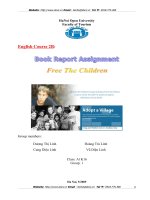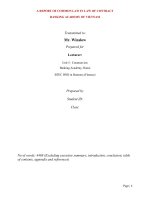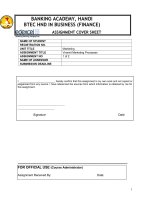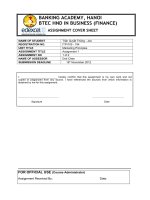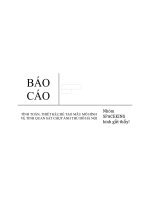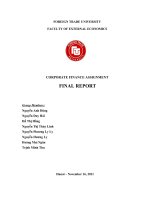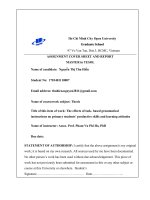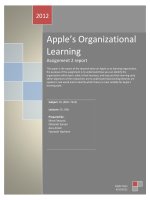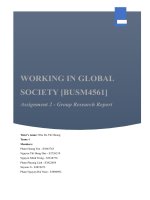Report IFI assignment
Bạn đang xem bản rút gọn của tài liệu. Xem và tải ngay bản đầy đủ của tài liệu tại đây (100.18 KB, 11 trang )
I.
QUESTION 1
1. Compare how the values of 5 currencies changed over time against USD in the past 3
years ( 2019-2022)
In table 1 and diagram 1 below, the US dollar is the base currency and the overvaluation and
undervaluation of 5 currencies (British pound, euro, Japanese Yen, Chinese Yuan and
Vietnamese Dong) South) are all compared to the US Dollar.
Looking at the table 1 calculated based on the Big Mac index, in general, in the recent years
from 2019 to 2022, the value of the British pound, the euro, the Japanese yen, the Chinese
yuan and The Vietnamese dong is all undervalued against the US dollar, except in July 2021, the
euro's value is overvalued against the US dollar, at 2.36%.
Out of the five countries mentioned, in the last three years, Vietnam is the country with the
highest undervaluation of its currency against the US dollar according to the Big Mac index.
Except for July 2022, the Japanese Yen is the most depreciated, with 45.07% based on the Big
Mac Index. On the contrary, from 2019 to 2022, the value of the Euro depreciated the lowest
against the US Dollar with the undervalued figure over the years being below 10%, except in
July 2021 the value of the Euro is appreciated against the US dollar. After Vietnam Dong , there
are Chinese Yuan and Japanese Yen with a relatively undervaluation against the US dollar. And
of the 5 countries, Britain is the one where the value of its currency has depreciated on average
against the US dollar.
Country
Under/Over Valuation Against Dollar**
Jul-19
Jul-20
Jul-21
Jul-22
United
States
0%
0%
0%
0%
Britain
12.92%*
11.26%*
-3.64%*
13.79%*
Euro area
-2.92%*
-0.70%*
2.36%*
-7.47%*
Japan
-23.87%
-24.57%
-28.04%
-45.07%
China
-35.24%
-35.72%
-29.88%
-30.93%
Vietnam
-40.59%
-40.93%
-39.22%
-42.78%
Figure 1: The change in values of the currencies against US dollar over the last 3 years
Note: (*) Percentage under/over valuation against the dollar is calculated as (Implied −
Actual)/(Actual),
except
for
the
Britain
and
Euro
area
calculations,
which
are
(Actual-Implied)/(Implied)
(**) See detailed calculation in the attached excel file in Appendix
h o w th e v a lu es of 5 cu r re n cies c h a n g e d ov er time
a g a in st U S D in th e p a st 3 y e a rs
Euro a re a
J apa n
C hina
Vietna m
-40.59%
-40.93%
-39.22%
-42.78%
-35.24%
-35.72%
-29.88%
-30.93%
-45.07%
-23.87%
-24.57%
-28.04%
-7.47%
-12.92%
-11.26%
-3.64%
-13.79%
Brit a in
-2.92%
-0.70%
0.00%
0.00%
0.00%
0.00%
Unit ed St a te s
Under/Over Valuation Against Dollar Jul-20
Under/Over Valuation Against Dollar Jul-22
2.36%
Under/Over Valuation Against Dollar Jul-19
Under/Over Valuation Against Dollar Jul-21
Diagram 1: The change in values of the currencies against US dollar over the last 3 years
Looking at the diagram above, it can be seen that Japan is a country where the value of its
currency depreciated against the US dollar, increasing sharply from 23.87% in July 2019 to
45.07% in July 2022. Besides, there is the slight increase of the undervaluation of Vietnam Dong
versus US Dollar over the years
Britain and the Euro area, in general, also have a rise in the deprivation of their currencies
against the US dollar, except for July 2021 when there is a big difference. Specifically, in July
2021, the British Pound was just undervalued by 3.64% versus the U.S. dollar and the Euro was
overvalued by 2.36% against the U.S. dollar.
Only the undervaluation of the Chinese currency against the US dollar decreased over the
years.
2. The implications
According to calculated data taken from the Big Mac Index, during the years from 2019 to 2020,
most of the value of 5 countries, the UK, European region, Japan, China, and Vietnam are
undervalued against the US dollar. Subtract the value of the Euro in July 2021, which is an
inversion. The undervaluation has the following positive and negative effects.
Countries with undervalued currencies relative to the US will have an export advantage. Goods
in these countries become cheaper for the US market in particular and the international market
in general. For example, in the event that the Chinese Yuan is undervalued against the US
currency, this is a good sign for Chinese exports. Chinese goods will be cheaper than US ones.
This can create a competitive advantage for products in the international market, increase
export sales and affect the Chinese economy as a whole.
However, countries whose currencies have depreciated against the US dollar will experience an
impact on the prices of imported products in those countries. For example, from 2019 to 2022,
Vietnam Dong depreciated relatively large against the US dollar. This means that the price of
Vietnamese products imported from the US or countries using US dollars will become more
expensive. This will likely affect the purchasing power of consumers in Vietnam and may lead to
an increase in the prices of domestic goods.
3. Evaluate the ability of Big Mac Index in predicting exchange rate movement.
The Big Mac Index is a way of measuring the value of a country's currency against the US
currency by comparing the selling price of a McDonald's Big Mac hamburger.
However, the Big Mac Index is not an accurate predictor of exchange rate movements, but
rather a relative measure of the value of a country's currency relative to the US currency.
Although there may be some correlation between the Big Mac price and the exchange rate,
there are many other factors that can affect the value of money, such as interest rates,
inflation, taxes, economic growth, political events and investor sentiment. Therefore, the ability
of Big Mac Index in predicting exchange rate movement is not strong.
II. QUESTION 2
1. Introduction
Two global corporations, PepsiCo, Inc. (PepsiCo) and 3M conglomerate business (3M), are the
foundation of our analysis. Particularly, PepsiCo is a significant US food and beverage company
whose goods are consumed by consumers more than a billion times every day in more than 200
nations and territories. In which, from 2020 to 2022, their operations outside of the United States
produced about 45% of the net income for the corporation. In terms of 3M, this is also a large US
corporation with over 100 years of development history, and operates in many fields such as
consumer goods, stationery, electricity, telecommunications, industrial products, products for the
transportation industry, health care and labor protection including more than 55,000 products.
With businesses operating in over 70 different countries, 3M today sells its goods in
approximately 200 nations, with sales outside the US accounting for about 60% of total revenue.
As a result, exposure to exchange rate risks is totally inescapable for multinational corporations,
particularly those with substantial scale like PepsiCo and 3M. In other words, even a slight
change in the value of the US dollar could endanger both companies' sales and financial success.
Therefore, currency risk management is extremely important and necessary. In the next section,
we will carefully analyze the tactics that Pepsico and 3M used to combat exchange rate risk over
the 3-year period, from 2020 to 2022.
2. Comparison
2020
2021
2022
1. Matching Cash Flow
1. Matching Cash
Flow
1. Matching Cash
Flow
3.Cross-currency
interest rate swaps
2. Forward contract
2. Forward contract
3. Cross-currency
interest rate swaps
3. Cross-currency
interest rate swaps
Hedging
Hedging
Hedging
Short, medium, long
Short, medium, long
Short, medium, long
MXN, RUB, CAD,
CNY, GBP, ZAR
MXN, RUB, CAD,
CNY, GBP, ZAR
MXN, RUB, CAD,
CNY, GBP, ZAR
Breakeven
Loss
Loss
2. Forward contract
Hedging instruments
Purpose
Maturity
Main foreign
currency hedged
Effectiveness
Figure 2: Hedging instruments following four aspects of Pepsico
Hedging instruments
2020
2021
2022
1.Forward contract
1.Forward contract
1.Forward contract
2.Option contract
2.Option contract
2.Option contract
3.Matching CF
3.Matching CF
3.Matching CF
4.Cross-currency
swap
4.Cross-currency
swap
4.Cross-currency
swap
Purpose
Maturity
Main foreign currency
hedged
Hedging,
Speculation
Hedging,
Speculation
Hedging,
Speculation
Short, medium
Short, medium
Short, medium
Liquid currencies
Liquid currencies
Liquid currencies
Loss
Gain
Gain
Effectiveness
Figure 3: Hedging instruments following four aspects of 3M
2.1.
Hedging instruments
It is evident from the two summary tables above that forward contracts and matching cash flow
are the top priority tools used by Pepsico and 3M. The two techniques are used not only to hedge
against the risk that changes in foreign currency values impact these group's sales, purchases and
borrowings; but also, to manage the risk from net investments (the currency risk in relation to the
translation of the net investments of its foreign operations into functional currency) in foreign
subsidiaries through sourcing purchases from local suppliers, negotiating contracts in local
currencies with foreign suppliers. In addition to these two instruments, both businesses utilize a
few more derivatives to control their exposure to foreign exchange risk, including Pepsico's
cross-currency interest rate swaps and Option contracts, cross-currency swap used by 3M.
2.2.
Purpose
In fact, companies can use financial instruments for a variety of purposes. For instance, 3M, this
company, besides the purpose of hedging, also uses derivatives to speculate and make a profit.
Pepsico, on the other hand, uses these tools for the sole purpose of hedging against the effect of
exchange rate fluctuations.
2.3.
Maturity
We learned from reading the two companies' annual reports that both give priority to short- and
medium-term financial instruments, and they both regulate maturity limits in particular. For
instance, depending on the currency, 3M uses a 12-, 24-, or 36-month horizon (maximum is 36
months) to hedge a percentage of their overall exposure. For Pepsico, forward contracts cannot
be longer than 2 years, and cross-currency interest rate swaps cannot be longer than 12 years.
2.4.
Currency
Because Mexico, Russia, Canada, China, the United Kingdom, and South Africa collectively
generated the largest part of Pepsico's total net revenue with 21% in 2020 and 23% for 2021 and
2022; the currencies of the aforementioned nations have been chosen by Pepsico as the primary
currencies for hedging. 3M uses financial hedges to mitigate currency risk only for more liquid
currencies like EUR, JPY, GBP... Because, for less liquid currencies, financial hedging is
frequently more expensive and subject to more restrictions. Thus, the company managed via
local operational actions using natural hedging tools instead, such as pricing, productivity, hard
currency, …
2.5.
Result
The use of financial instruments in 2020 did not work out in 3M because 3M had a loss while
Pepsico had no loss, which met their hedging purpose. Regarding the upcoming two years, the
two companies have demonstrated completely different outcomes. While 3M made money in
2021 and 2022, Pepsico's use of financial instruments resulted in losses in both of those years.
III. QUESTION 3: Mini-case chapter 2
1. Why would the Chinese government wish the renminbi to become a global currency? What are
the costs and benefits of that greater global role?
1. 1. Why would the Chinese government wish the renminbi to become a global currency?
Because China is currently the world's largest commercial trader and has the world's second-biggest
economy after the United States, the Chinese government requires more easily accessible currency. China
believes that if many of its commercial transactions are paid in RMB, then China's trade will be less
affected by the lack of dollars or any other foreign currency. The renminbi would make cross-border
financial transactions safer for China since it would lower the country's exposure to currency rate risk and
allow it to become less dependent on foreign institutions and international payment systems. Furthermore,
the use of RMB for international payments will facilitate them to be processed by a payment system
under China's authority.
1.2. What are the costs and benefits of that greater global role?
China may incur some drawbacks as a result of its greater global role. First, if they are given unrestricted
access to China's market and currency, the renminbi's value might increase, which could reduce China's
export competitiveness and negatively affect China’s exports Additionally, there is worry that significant
sums of Chinese savings may leave the country in search of higher returns as interest rates in important
capital markets, like the dollar and euro, have started to rise. Also, if China's currency is the international
currency, the renminbi can become the reserve currency. However, when the renminbi becomes the
reserve currency, China will have a Triffin Dilemma problem. This means that, when China's renminbi is
used as an international currency, China has to print more money to meet global as well as domestic
demand. This could lead to inflation and the depreciation of the renminbi, harming China's interests. At
the same time, other countries may not want to use the Chinese currency anymore due to its decline in
value. In short, the renminbi becoming an international currency will adversely affect China's monetary
policy.
However, besides the above disadvantages, RMB becoming a global currency also brings about some
benefits for China. It can minimize exchange risk, as Chinese investors would be independent from other
countries’ currency while making an international transaction. Globalization of RMB can promote the
development of China's financial market, since the government and investors are able to borrow capital in
RMB with low interest rates. In general, countries will have higher demand for the renminbi if the
currency is used for invoicing and commercial payments.
2. What are the theoretical requirements in order for a currency to be considered internationalized or
global?
The following are the theoretical prerequisites for a currency to be termed internationalized or global.
First of all,an international currency needs to be readily accessible for trade or it means that the
international currency is highly liquid. It must be accepted and easily used around the world, including in
international commercial transactions and in other financial activities. Secondly, the international
currency is used for international investment (capital account/market activity). Finally, the international
currency takes the function of a reserve currency if there are enough foreign central banks to own it.
3. At what stage is the Chinese renminbi in its globalization process? What is keeping it from
becoming fully globalized?
3.1. At what stage is the Chinese renminbi in its globalization process?
The Chinese renminbi globalization process is restricted in the second stage. Because, while the renminbi
is ready for trading, the Chinese authority is not prepared for such a great number of foreign investments.
China is an appealing market for investors globally with the highest population of 1.4 billion people. Still,
since the demand for the renminbi is in such high demand, its value will definitely soar if it becomes an
international currency. Therefore, Chinese investors will seek to use the renminbi to invest in foreign
countries, where they may earn a higher return than previously. As a result, Chinese savings would flow
out of their country.
3.2. What is keeping it from becoming fully globalized?
It can be said that China's fiscal and monetary policies keep the renminbi from becoming fully globalized.
The fiscal and monetary policy still faces many risks and challenges, including issues of controlling
capital outflows, dependence on state-owned companies and government intervention in the financial
market.
Moreover, due to a number of variables, including government interference and the lack of transparency
in monetary and fiscal policy, the present renminbi has not yet attained this degree of reliability and
stability.
